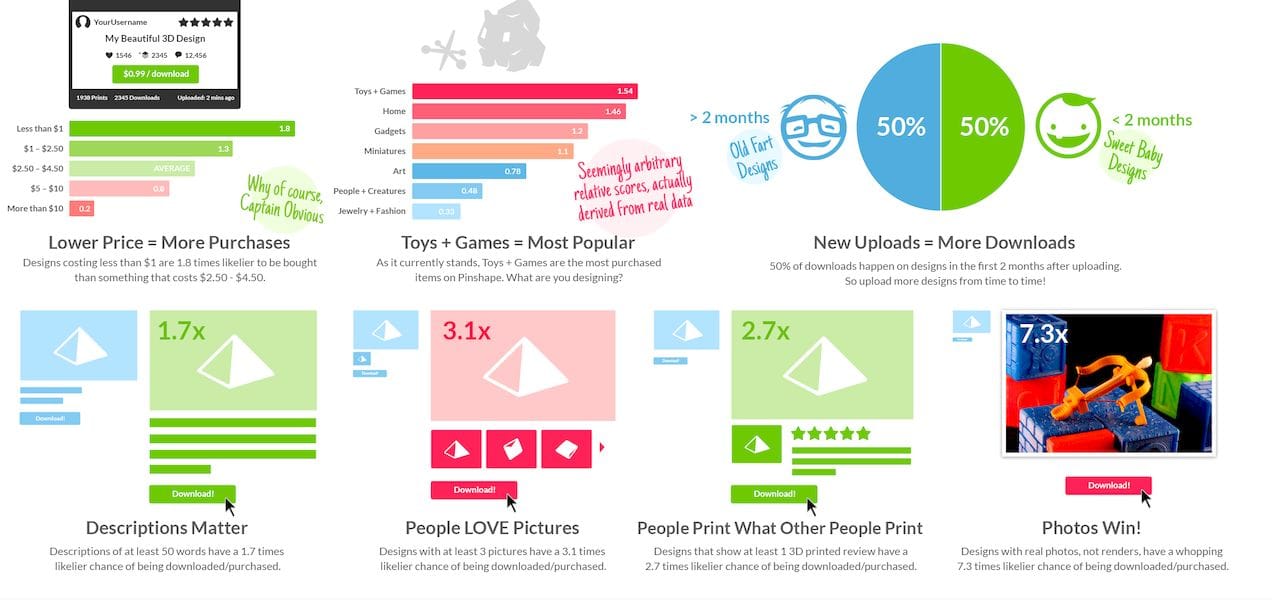
A recent post from Pinshape provides some interesting insights into the thinking patterns of those who buy 3D models online.
If you’re not familiar with Pinshape, it’s an excellent source for casual 3D models, much like Thingiverse, YouMagine or MyMiniFactory. Like many of those, Pinshape is aligned with a 3D printer manufacturer. While Thingiverse has MakerBot, and YouMagine has Ultimaker, Pinshape is aligned with Formlabs.
In fact, the formerly independent Pinshape was near death when it was rescued by Formlabs to become a much more powerful repository of 3D models for anyone to use.
While there are many free 3D models on Pinshape, the service also permits designers to post 3D models for sale on the site.
The company has been marketing 3D models to the public for years and has accumulated considerable knowledge of how best to do so. They’ve analyzed their sales and traffic statistics to come up with a series of recommendations for those using their system.
But after reading through them, I believe we can get a glimpse into the minds of these buyers. Let’s go through what Pinshape found.
Some of their advice is obvious, like lower prices sell more, as do items with images. But let’s look further.
Pinshape says:
The most downloaded designs tend to be those that fall into the Toys & Games or the Home categories, while Jewelry & Fashion falls way behind.
Thoughts: it’s possible that 3D printers used by buyers, which would typically be simple desktop units, do not have sufficient resolution or material types to warrant 3D printing jewelry or fashion items. However, game pieces and toys, often used by children, would not have such constraints.
It seems that buyers are a bit picky when it comes to personal fashion.
Pinshape says:
When it comes to getting noticed, staying active on a marketplace is key for designers. Regularly posting new designs for sale really helps, since 50% of all transactions happen in the first 2 months after being listed. Keeping a fresh portfolio means more views and sales for the new items, as well as the older items in your portfolio.
Thoughts: This makes sense. It seems that buyers are constantly looking for something new, and that the uniqueness of 3D printing must be constantly leveraged in order to address their needs. There is less interest in “standard objects”.
Pinshape says:
Having a description of your design goes a long way; with 50 words or more, you’re 1.7 times more likely to sell something than if you have a shorter description.
And
Makers like to know what they’re getting before they decide to buy 3D printable files. In this case, the data backs that up, indicating that you’re a whopping 3.1 times more likely to sell a design when you have at least 3 different pictures of your model in your listing.
And
Our data shows that Prints (uploaded proof that a design will print successfully, along with the slicing settings to get the same results) make a design 2.7 times more attractive to makers than those that don’t have any proof or printability.
And
We found that designs with photos of real, already 3D printed designs are 7.3x more likely to be sold than those with computer generated renders.
Thoughts: All of these points lead to only one conclusion: 3D printer operators are extremely wary of unknown 3D models. They don’t want to waste time or materials on failures. They want proof!
This further suggests that the display mechanisms for 3D models are insufficient, as people want more imagery. I would be interested to know the effects of 3D viewers on buying patterns, but I suspect that a 3D viewer that ALSO provided some kind of “visual printability analysis” could be extremely interesting.
Bottom line: 3D printer operators buy 3D models for things they will actually use, and only if they are assured they can actually be 3D printed.
Via Pinshape

